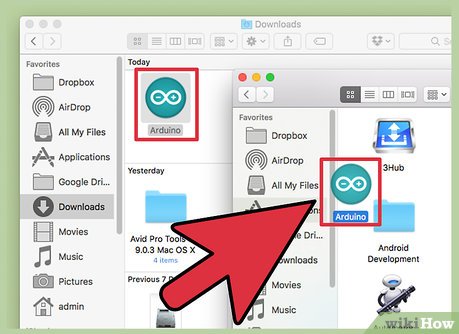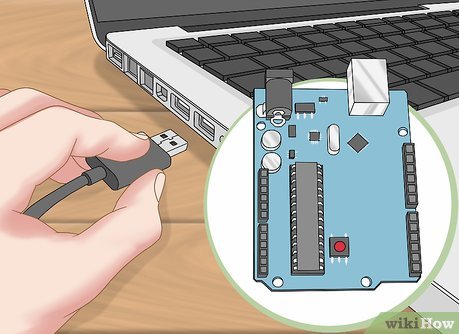How to Set Up an Arduino Uno
Part 1 of 4:
Setting Up on Mac OSX
-
 Download and mount the latest Arduino package.
Download and mount the latest Arduino package. -
 Run the FTDIUSB Serial driver included.
Run the FTDIUSB Serial driver included. -
 Once that is complete, drag the application to your applications folder. You will have to restart your device to activate the new drivers.
Once that is complete, drag the application to your applications folder. You will have to restart your device to activate the new drivers. -
 Connect the Arduino. The first time you connect the Arduino, OSX will tell you that it has detected a new interface. Simply click on 'Network Preferences' and then click 'Apply.'
Connect the Arduino. The first time you connect the Arduino, OSX will tell you that it has detected a new interface. Simply click on 'Network Preferences' and then click 'Apply.'
Part 2 of 4:
Setting Up on Windows 7
-
 Begin by downloading the latest version of the Arduino package and unzipping it. It may be around an 80MB download, fully expanded to 230MB, so depending on your internet connection you may want to grab a coffee.
Begin by downloading the latest version of the Arduino package and unzipping it. It may be around an 80MB download, fully expanded to 230MB, so depending on your internet connection you may want to grab a coffee. -
 Plug the Arduino into your PC with the included USB cable. Close any pop-up windows and decline any search for drivers through Windows' tool.
Plug the Arduino into your PC with the included USB cable. Close any pop-up windows and decline any search for drivers through Windows' tool. -
 Click on 'Start,' and then type devmgmt.msc. Press ↵ Enter and the Device Manager panel should open.
Click on 'Start,' and then type devmgmt.msc. Press ↵ Enter and the Device Manager panel should open. -
 Find the 'Other devices' section. You should see an Arduino Uno on the list, with one of those yellow "problem" indications. Double-click on that, select 'Update Drivers' and then select 'Browse my computer for driver software.'
Find the 'Other devices' section. You should see an Arduino Uno on the list, with one of those yellow "problem" indications. Double-click on that, select 'Update Drivers' and then select 'Browse my computer for driver software.' -
 Select 'Let me choose a Driver,' click on 'All Devices', 'Have Disk,' and then go to the 'Downloads' folder. In the drivers folder, you should see an Arduino Uno file. Select that. The driver installation process will deem it a "communications port" and report a "mistake unsigned driver" when installing. Ignore that, proceeding with the installation anyway.
Select 'Let me choose a Driver,' click on 'All Devices', 'Have Disk,' and then go to the 'Downloads' folder. In the drivers folder, you should see an Arduino Uno file. Select that. The driver installation process will deem it a "communications port" and report a "mistake unsigned driver" when installing. Ignore that, proceeding with the installation anyway.
Part 3 of 4:
Configuring the Board and Port
-
 Launch the Arduino application from either the 'Download' folder or the 'Applications' folder.
Launch the Arduino application from either the 'Download' folder or the 'Applications' folder. -
 Set up the port and board. On either system, you may have a tools menu. Click that and ensure a matching board is chosen. The Uno is the default and may already be highlighted in your installation. Ensure the serial port is chosen correctly, too
Set up the port and board. On either system, you may have a tools menu. Click that and ensure a matching board is chosen. The Uno is the default and may already be highlighted in your installation. Ensure the serial port is chosen correctly, too- On a Mac, the port names are a bit more confusing, but it will be one of the listed USB ports. Perhaps it will be listed as cu-USB.
Part 4 of 4:
Run Your First Application
-
 Click 'Open,' and from the dialog select the example application: Basics -> Blink.
Click 'Open,' and from the dialog select the example application: Basics -> Blink. -
 Test the setup. To ensure that the board is working and is connected correctly, go ahead and click 'Upload.'
Test the setup. To ensure that the board is working and is connected correctly, go ahead and click 'Upload.'- After a short moment compiling the application, some orange lights that are labeled TX / RX on the Arduino will begin flashing. This means that data is being transmitted or received. When the process is done, the code will be run immediately.
-
 Start experimenting. That is as far as this tutorial will take you. You've now set up your Arduino and figured out how to upload apps to it, confirming that it works properly.
Start experimenting. That is as far as this tutorial will take you. You've now set up your Arduino and figured out how to upload apps to it, confirming that it works properly.
4 ★ | 1 Vote
You should read it
- How to install Arduino IDE on Mac
- Download and install Arduino on the computer
- Why is the new Arduino Uno R4 a game changer for manufacturers?
- How to install Arduino IDE on Debian 10
- How to install the Arduino IDE on CentOS 8
- How to add libraries in Arduino
- How to program Arduino with an Android phone
- Download Arduino IDE 1.8.13: Great programming software for beginners
May be interested
- How to Use Ultrasonic Sensors in Arduino Project
 arduino is an open-source microcontroller platform used in many applications. arduino boards are able to read inputs such as light on a sensor or the press of a button and turn it into an output. this wikihow teaches you how to create an...
arduino is an open-source microcontroller platform used in many applications. arduino boards are able to read inputs such as light on a sensor or the press of a button and turn it into an output. this wikihow teaches you how to create an... - How to connect two Arduino boards using I2C
 while a single arduino can accomplish many tasks, some projects may require the use of more than one board to handle different functions.
while a single arduino can accomplish many tasks, some projects may require the use of more than one board to handle different functions. - Difference between Elegoo and Arduino
 if you've ever bought an arduino board, you may have seen elegoo boards with a cheaper starter kit. both are good options. so what is the difference between elegoo and arduino?
if you've ever bought an arduino board, you may have seen elegoo boards with a cheaper starter kit. both are good options. so what is the difference between elegoo and arduino? - How to Program Arduino with Raspberry Pi
 running a program on an arduino is easy, but have you tried doing it with the pi? the raspberry pi is powerful enough to be a standalone computer and also good enough to program microcontrollers.
running a program on an arduino is easy, but have you tried doing it with the pi? the raspberry pi is powerful enough to be a standalone computer and also good enough to program microcontrollers. - Compare Raspberry Pi and Arduino
 both raspberry pi and arduino are popular boards for iot projects. although they are not the only options, each of these tools has a large following and tons of online resources.
both raspberry pi and arduino are popular boards for iot projects. although they are not the only options, each of these tools has a large following and tons of online resources. - What is PWM in Arduino?
 pwm is a widely used concept in physics, electronics and telecommunications. it is defined as a signal modulation form to obtain analog waveforms from digital inputs.
pwm is a widely used concept in physics, electronics and telecommunications. it is defined as a signal modulation form to obtain analog waveforms from digital inputs. - How to install Arduino IDE in Ubuntu
 all you need to do is buy an arduino, add some accessories, install the arduino ide and you're ready to start your new project!
all you need to do is buy an arduino, add some accessories, install the arduino ide and you're ready to start your new project! - How to Run a Toy DC Motor by Using Arduino
 one of the most basic (and fun) things you can do with an arduino microcontroller is wire a dc motor. you can make a simple table fan or go all in and build a remote controlled car. either way you will need to know how to actually make a...
one of the most basic (and fun) things you can do with an arduino microcontroller is wire a dc motor. you can make a simple table fan or go all in and build a remote controlled car. either way you will need to know how to actually make a... - How to install and run Arduino IDE on Raspberry Pi
 if you are familiar with the arduino ide programming environment, you may also want to use it on raspberry pi. here's how to install and run arduino ide on raspberry pi.
if you are familiar with the arduino ide programming environment, you may also want to use it on raspberry pi. here's how to install and run arduino ide on raspberry pi. - How to Make a Simple Proximity Sensor Using Arduino
 this article discusses how to make a simple proximity sensor constructed using leds and arduino which is able to detect the distance between the sensor and the object in front of it without any physical contact. the sensor will give a...
this article discusses how to make a simple proximity sensor constructed using leds and arduino which is able to detect the distance between the sensor and the object in front of it without any physical contact. the sensor will give a...
















 How to Restart a Mac
How to Restart a Mac How to Connect a Mac to the Internet
How to Connect a Mac to the Internet How to Open Task Manager on Mac OS X
How to Open Task Manager on Mac OS X How to Undo a Mac App Update Without Time Machine
How to Undo a Mac App Update Without Time Machine How to Write to an External Hard Drive on Mac OS X
How to Write to an External Hard Drive on Mac OS X How to Use Spaces on Mac OS X
How to Use Spaces on Mac OS X